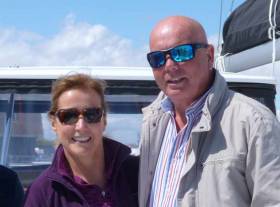Displaying items by tag: Lagoon Catamaran
MGM Boats Celebrate Lagoon Catamaran 40th Birthday With 'Exclusive Days' Display in Bordeaux
Ireland's MGM Boats, a leading boat broker, is all set to celebrate its 15-year partnership with French yacht builder Lagoon Catamarans. The year 2024 will be extra special for the boat builder as it marks 40 years of production. In honour of these milestones, MGM Boats is promoting a special weekend event called 'Exclusive Days', where visitors can see the wide range of catamarans on display in Bordeaux.
The event is scheduled to take place from 6th to 9th March 2024 and will offer an opportunity to discover a wide range of catamaran models. The Lagoon 40, Lagoon 42, Lagoon 46, Lagoon 51, Lagoon 55, Lagoon 60, Sixty 5, Seventy 7 and Sixty 7 are set to be on display.
MGM Boats has been representing the Lagoon Catamarans brand in Ireland for the past 15 years and has built a reputation for providing high-quality boats to its customers. The partnership has been successful, with Lagoon Catamarans being one of the most popular catamaran brands in Ireland.
As regular Afloat readers know, Afloat has been charting the Lagoon story on Afloat.ie right back to when WM Nixon declared the Lagoon 52 Catamaran was Irish sailing's shining white hope in 2014. In 2018, the same author charted an Irish couple's dream retirement cruise on a Lagoon Catamaran, and in 2021, MGM launched the Lagoon 55 in Ireland.
The 'Exclusive Days' promotion is expected to attract a lot of visitors, who will have the opportunity to see the latest models and designs from Lagoon Catamarans. The event promises to be a great opportunity for anyone interested in boating to see the latest trends in the industry, as well as to celebrate the success of MGM Boats and Lagoon Catamarans.
More details from MGM's Sales Director Ross O'Leary on +353 [0]87 6642297 or [email protected]
MGM Boats to Follow Successful Cannes Showcase With Strong Presence in Southampton From This Friday
Following a successful stint in Cannes last week, MGM Boats will be on the Prestige and Jeanneau stands for the duration of the Southampton International Boat Show which kicks off this Friday 16 September.
The Dun Laoghaire-based boat sales agents will have a full sales team working the show and available to show a host of new boats from its ranges.
For the Prestige marque, that means the 420F, 460F, 520F and 590F motor yachts, alongside Jeanneau’s Sun Odyssey (380, 410, 440 and 490) and Sun Fast 3300 sail boats.
Powerboats from Jeanneau on show include the Cap Camarat (7.5 WA Série3, 9.0 WA and 10.5 WA Série2), Merry Fisher (795 Série2, 795 Sport Série2, 895, 895 Sport an1095) and NC37.
And the Lagoon Catamarans brand will be represented by the Lagoon 46 and Lagoon 42.
The MGM Boats sales team looks forward to seeing you in Southampton. For more details, get in touch with [email protected].
ARC+ 2021, World Cruising Club’s two-stage transatlantic rally to Grenada, set sail today from Las Palmas de Gran Canaria with 70 boats spirited away by the tradewinds bound for Mindelo Marina in Cape Verde for the first leg. Years of planning, months of preparations, and days of checking off the jobs list has gone in ahead of today's departure, which saw crew from 24 different nationalities heading off to begin their Atlantic adventure.
Three Irish entries were among today's departures; two multihulls and a monohull yacht.
Conor Haughey is the skipper of Hibernian, a Dublin-based Moody 54DS. Brendan Cahill set sail in Lir, a Lagoon 450 as did County Kerry's Brian O'Sullivan and Frances Clifford in the Lagoon 46 Navillus.
 Brian O'Sullivan and Frances Clifford's Lagoon 46 Navillus
Brian O'Sullivan and Frances Clifford's Lagoon 46 Navillus
The rally began with a programme of pre-departure activities to ensure the boats and crews were suitably ready for departure. From the end of October, Las Palmas Marina has become a colourful sight with yachts dressed overall and rally flags flying. ARC+ has had a real family feel this year with 17 boats sailing with children on board and a total of 33 kids set to enjoy their first taste of Atlantic sailing on the rally.
Following COVID-secure protocols, organised activities for participants prior to departure have included a range of seminars, crew suppers and drinks events creating a great community spirit amongst the sailors. Rally organisers World Cruising Club have supported their preparations with one-to-one safety checks of boat equipment and smoothing their logistics, and the many marine businesses around the city have assisted with getting the boats ship shape for departure.
There was great excitement around the docks of Las Palmas marina as start day dawned and lines were slipped to head out to the starting area. “We are really looking forward to the departure. We deferred from last year’s rally so it seems like we’ve been waiting such a long time so we just can’t wait to get going!” said Derek Frame, British owner of the Wauquiez 47PS Delite, “It was a really good Skippers Briefing yesterday and we’ve had great advice and help from World Cruising Club, so I feel we are prepared and ready go now.”
Stephan Friedel, skipper of the German Catana 531 Rob Roy III says that he has enjoyed his time here but after four weeks in Gran Canaria it will be good to start. “We want to get going now and everyone is ready and wants to get into warmer tropical weather. It’s time to go now it’s a bit cooler here! My first Atlantic crossing was in 1998, but this will be my first rally and my first as skipper - a dream that I’ve had since I was a young boy, so I’m excited that finally it has come true!”
As forecast, the winds on start day provided a rock and roll departure with 15-20knts blowing steadily in the starting area from the North East and a significant swell running outside the shelter of the port. The countdown began from ARC+ Rally Control onboard ARC yacht Vahine (FIN) acting as committee vessel for the ARC+ starts. At 12:45, the multihulls were led away by the impressive Outremer 51 Piment Rouge (FRA) and Neel 47 Bigbird (USA) flying across the line close to the shore to the delight of the spectators strolling along the Avenida Marítima.
At 13:00 it was the turn of monohulls with the Cruising Division setting off on the 865nm passage to Mindelo. It was the Beneteau Oceanis 40, Sala from Norway sailed by the Christensen family under the watchful eye of their weather expert Mads Liestøl Christensen who were first to cross the line. The Irish Moody 54 DS Hibernian skippered by Conor Haughey was next and another Norwegian family boat, Albicilla, crossed in third place with a big cheer on board. The start was quite a sight as the fleet bounced through the ocean waves and bid farewell to the city of Las Palmas de Gran Canaria.
For their first night at sea, moderate trade winds are expected to whisk the fleet away from Gran Canaria before decreasing as the yachts get closer to the Cape Verde Islands in the coming days.
On arrival in Mindelo, there is an exciting programme for crews to explore ashore and the stopover has been extended to give crews more time to enjoy the islands. The first boats are expected from Friday 12 November and will receive a warm welcome from the teams of Marina Mindelo staff and World Cruising Club.
Following the stopover, ARC+ has a new Caribbean destination this year and the fleet will be sailing to Camper and Nicholsons Port Louis Marina on the island of Grenada. The re-start from Mindelo will be on Friday 19 November.
All the yachts are equipped with a YB Tracker, regularly broadcasting their position to the online Fleet Viewer and YB Races app for friends and family to follow the fleet. Tales of fishing triumphs and tradewind sailing will also be sent to the World Cruising Club website, as participants share their ocean adventures.
There are three transatlantic departures from Las Palmas de Gran Canaria organised by World Cruising Club under the Atlantic Rally for Cruisers banner: ARC+ 2021, ARC 2021 and ARC January 2022.
Dun Laoghaire yacht broker MGM Boats be exhibiting on the Prestige Yachts, Lagoon Catamarans and Jeanneau Sail & Powerboat stands for the full duration of the show from 7-12 September.
Gerry Salmon, Ross O’Leary and Joss Walsh will be available to show over a host of new models for 2022 at the event, which will cover two exhibition spaces at the Vieux Port and Port Canto.
As the Cannes boat show promises as usual to be a very busy boat sales event, the MGM Boats team advises making a prior appointment to view your choice of boat:
- Prestige: 420, 520, 590, 460 S, 690 X70
- Lagoon: Seventy7, Sixty5, 55, 46, 42, 40
- Jeanneau Sail: Sun Odyssey 410, Sun Odyssey 440, Sun Odyssey, 490, 54, 60
- Jeanneau Power: Leader 36, Merry Fisher 1095 Fly, Cap Camarat 12.5 WA, NC 37, Merry Fisher 10.95, Cap Caramat 10.5 WA
To make an appointment or if you would like to receive further information on the boats displayed, contact the sales team at [email protected]
MGM Boats Launch the Lagoon 55 Catamaran for Ireland
Following several weeks of teasing, Lagoon (along with its Irish agent MGM Boats) has unveiled its new model, the Lagoon 55 catamaran. Straight out of the shipyard at Construction Navale Bordeaux, the first prototype was launched last month, from the quayside on the Garonne River.
For catamaran lovers, who have been following Lagoon’s fabulous history for more than 30 years, the name of this model will certainly evoke fond memories: the Lagoon 55 was in fact the very first Lagoon to have been launched, back in 1987. With naval architects Marc Van Peteghem and Vincent Lauriot-Prévost (VPLP design) at its side, Lagoon began to make its mark, and gradually became the undisputed leader in the leisure catamaran market. 34 years later, there are more than 6,000 Lagoon catamarans sailing all the seas of the world…
It’s difficult to compare the Lagoon 55 of 1987 and the Lagoon 55 of 2021, as innovations have changed the hulls and interior layout. However, we can say without any doubt that Lagoon has remained faithful to its roots and values: to offer a safe and comfortable sailing yacht, to go far and travel. A yacht where life is good.
 Lagoon 55 - The cockpit is totally open, giving a panoramic and uninterrupted view
Lagoon 55 - The cockpit is totally open, giving a panoramic and uninterrupted view
At first glance, the striking innovation on this new, just-launched Lagoon 55 is the aft area which has been totally redesigned to offer optimal circulation on board, creating a vast terrace on the sea. The cockpit is totally open, giving a panoramic and uninterrupted view, while the sugarscoops have been conceived both for easier access and also to become real additional living spaces.
Emphasis has also been placed on light and ventilation, with overhead windows in the coachroof complementing the large vertical ones, creating that “open air” effect so dear to Massimo Gino, the interior designer (Nauta Design): “Opening the interiors to such an abundance of natural light allows for a seamless connection with the landscape and the natural environment”.
Available in 4, 5 or 6-cabin versions, with large private bathrooms whatever the chosen configuration, the Lagoon 55 offers impressive volumes, bringing real added value compared to the Lagoon 52 that it replaces in the range. The Lagoon 55 has a modern design while retaining the codes of the brand's DNA. This new model reveals a particularly carefully worked exterior design, with its new signature on the coachroof overhang and its raised bulwark, giving it a sleek and elegant profile.
Following the press conference on March 12th, the Lagoon 55 will set sail with our technical teams for a long series of intense sailing tests. She will make a stop at the International Multihull Show at La Grande Motte, in the South of France for her World Premiere at the end of April and will then start a tour of the Mediterranean. The first stop will be at the beginning of June at the new Lagoon test base in Port-Ginesta, near Barcelona, where journalists and clients will be able to try the boat in optimal conditions.
Meanwhile, MGM Boats will have a Lagoon 42 in Dun Laoghaire Harbour this summer that will be available for test sails along with another Lagoon, the 450s also arriving into the harbour.
When does life really start? asks W M Nixon. Maybe it’s when the kids have grown up and left home, and you’ve the resources to buy the dream second home for the perfect holidays of your retirement.
Of course, 95% of people in this situation would be thinking in terms of that dream second home as a cottage or ultra-modern house somewhere on a magic coastline, or in a very special bit of countryside. But when George and Mary Coombes of Castleknock in Dublin found that everything in the jigsaw would be coming together for a very special way of life to begin as his 60th birthday approached in May of this year, their choice for the essential second home was rather different.
They sought a boat which would be capable of crossing oceans, at least in the more meteorologically gentle parts of the world. But this dreamship would then have to provide all the amenities of a comfortable house once they’d reached one of their desired cruising areas. In the end, all roads led to a roomy multi-hull, and in their choice they were guided by Ross O’Leary of MGM Boats in Dun Laoghaire.
 A business relationship which developed into friendship – Ross O’Leary of MGM Boats with Mary and George Coombes aboard Realta Bheag shortly after the owners had sailed their new boat back to Ireland from Les Sables-d’Olonne in the Bay of Biscay. Photo: W M Nixon
A business relationship which developed into friendship – Ross O’Leary of MGM Boats with Mary and George Coombes aboard Realta Bheag shortly after the owners had sailed their new boat back to Ireland from Les Sables-d’Olonne in the Bay of Biscay. Photo: W M Nixon
They’d ample time to make their final selection, as George took retirement from a full career – initially serving with the Army, then 30 years in An Garda Siochana - at the age of 50, leaving the two of them with a decade to elapse before all aspects, including expected resources and their four children’s maturity, were properly in place to enable them to get up and go.
George had taken to sailing with enthusiasm once he’d discovered it through the Army’s link-up with the Glenans base which used to be on Bere Island in West Cork, continuing with the Gardai Sailing Club’s First 27.7 in Dublin Bay and the Army’s group-owned Amel 48 in Croatia, where he acquired a passion for cruising in attractive locations. Mary – originally from Sligo, but long since thinking of herself as a true Dub – began to be interested as well, and with his retirement approaching they started to think seriously about how to go about it. By 2014, they’d taken their Yachtmaster Coastal Certificates with Ronan O Soichru of Irish Offshore Sailing in Dun Laoghaire, and were researching their many options as avid followers of the best cruising forums.
 The Lagoon 450 S Realta Bheag (above and below) develops the multi-hull concept in such a total way that sailors accustomed to mono-hulls have to learn a new completely new mindset in order to understand her role. Photos: W M Nixon
The Lagoon 450 S Realta Bheag (above and below) develops the multi-hull concept in such a total way that sailors accustomed to mono-hulls have to learn a new completely new mindset in order to understand her role. Photos: W M Nixon
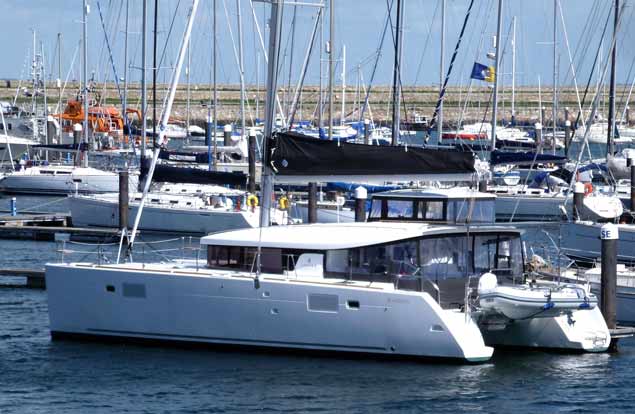
Although they’d had mainly mono-hull experience in their cruising, by 2015 the clearly-defined nature of their future requirements pointed increasingly to a multi-hull, and they were in regular exchanges with Ross O’Leary of MGM Boats. O’Leary for his part was intrigued by the story of how this engaging couple had come through their unusual routes to the heart of the sailing dream.
Thus something which initially had been a business enquiry fielded by someone at the core of the sailing establishment (in addition to selling boats, Ross somehow finds the time to be the Captain of the Dublin Bay Laser fleet) quickly became a professional connection blossoming into friendship, and for more than two years they shared the quest of finding the ideal boat for a complex set of requirements.
The multi-hull solution provided the answer in terms of space and a stable platform which would feel user-friendly for the many friends and relations whom they expected to join them at various stages of their planned odyssey. But it had to be a special multi-hull which puts at least as much emphasis on comfort when the boat is at rest as it does on performance.
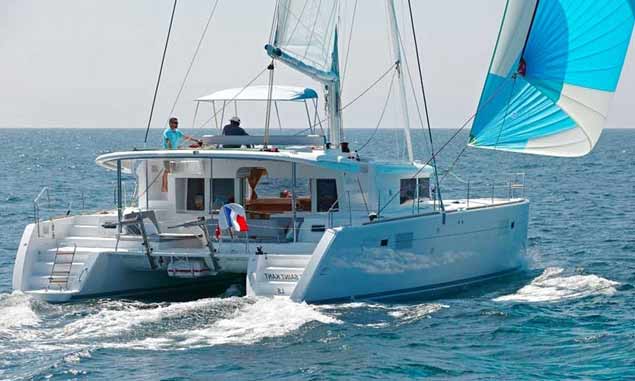 With sheets freed, the hyper-comfortable Lagoon 450S (seen here in a different version) can give a good account of herself under sail
With sheets freed, the hyper-comfortable Lagoon 450S (seen here in a different version) can give a good account of herself under sail
No-one would claim that the distinctive Lagoon range are the fastest catamarans on the ocean. But they can slip along at a brisk pace with sheets freed, and they do so in a remarkably smooth style. With their small keels, they can make to windward under sail if required, yet with a powerful engine in each hull, there’s a very viable alternative means of getting there.
But once in port, whether in harbour or in a secluded paradise anchorage, the Lagoons are in a class of their own. The sense of space skillfully and very attractively utilised is all-pervading. This really is a floating holiday home which can be easily moved to the next location by whatever method of propulsion suits the mood of the day.
So everything pointed to a Lagoon. But with a constantly-evolving range and a special reputation for design development, the big question came down to the optimum Lagoon size and type to suit George and Mary’s admittedly quite substantial budget, while matching their expectations of size-manageability as set against the requirements for space - lots of space, and lots of comfort, both below and on deck
But the demand for Lagoons is such that a standard order can take up to 18 months to fulfill. Yet in the end, having decided that the Lagoon 450 S best met their needs, George and Mary got a new one in almost record time in September 2017. They bought her at the Cannes Boat Show, as one does……
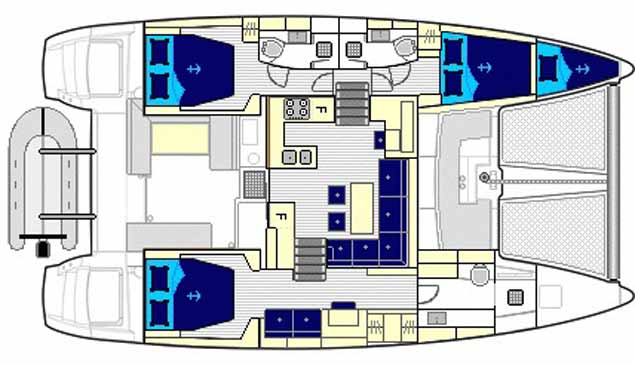 George and Mary’s preference was for an owner’s master-cabin taking up all of the starboard hull, and two en suite guest rooms in the port hull, with the exceptionally roomy saloon and galley in between
George and Mary’s preference was for an owner’s master-cabin taking up all of the starboard hull, and two en suite guest rooms in the port hull, with the exceptionally roomy saloon and galley in between
Ross O’Leary was working at the Show, but also keeping his eye on the Lagoon 450 S on display, as it matched the Coombes’ requirements through being the three-cabin owners’ layout, while the interior joinerywork was in the darker finish which Mary had said she would prefer. Although the type was selling well, other potential owners and charter operators wanted different options. So as the show progressed, Ross called George and Mary and told them to get themselves down to Cannes pronto, as he felt an attractive bargain could be struck there and then on what seemed to be a boat very close indeed to their dreamship.
Thus it was that we found ourselves in the MGM Boat Show at Howth YC Marina in May 2018, shooting the breeze about those who dare to realize the dream aboard the new Lagoon 450 S Realta Bheag, that same boat from Cannes, but now with many factory-added extras to enable George and Mary to sail the seas as self-reliantly as possible, yet provide a proper and comfortable welcome for family and friends when they came as guests.
That the boat was ideal for this became evident in Howth as visitors came and went with ease of movement – boat buffs were there, and friends and family, with the latter category ensuring that Ross O’Leary was at one stage left literally holding the baby, which he did with style as befits a man who has seen it all.
 With all the onboard comings and goings of visitors, Ross O’Leary found himself left holding the baby……Photo: W M Nixon
With all the onboard comings and goings of visitors, Ross O’Leary found himself left holding the baby……Photo: W M Nixon
As for the boat herself, people accustomed to mono-hulls have to adjust their mind-set completely in order to assess the merits of a spacious accommodation which essentially stays virtually level, thereby allowing a freedom of movement through extensive spaces both below and in the several multi-purpose areas on deck.
It takes a while to grasp that this luxurious layout, which speaks eloquently of choices – particularly in sunshine situations – is combined in a workmanlike seagoing vessel with twin 57hp Yanmar diesels, virtual self-sufficiency with generators, solar panels and other sources of power creation, an easily-handled yet effective rig, and comfortable accommodation for six with the starboard hull entirely given over to the owner’s master-cabin with all amenities, while the port hull has two en suite doubles.
 Time for women’s talk….the spaciousness of the saloon is central to the concept. Photo: W M Nixon
Time for women’s talk….the spaciousness of the saloon is central to the concept. Photo: W M Nixon
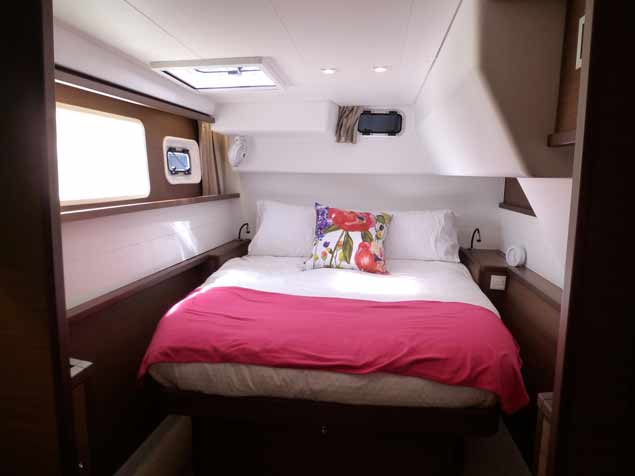 The owners suite takes up the entire accommodation area in the starboard hull – the master-cabin comes with changing area and all en suite facilities. Photo: W M Nixon
The owners suite takes up the entire accommodation area in the starboard hull – the master-cabin comes with changing area and all en suite facilities. Photo: W M Nixon
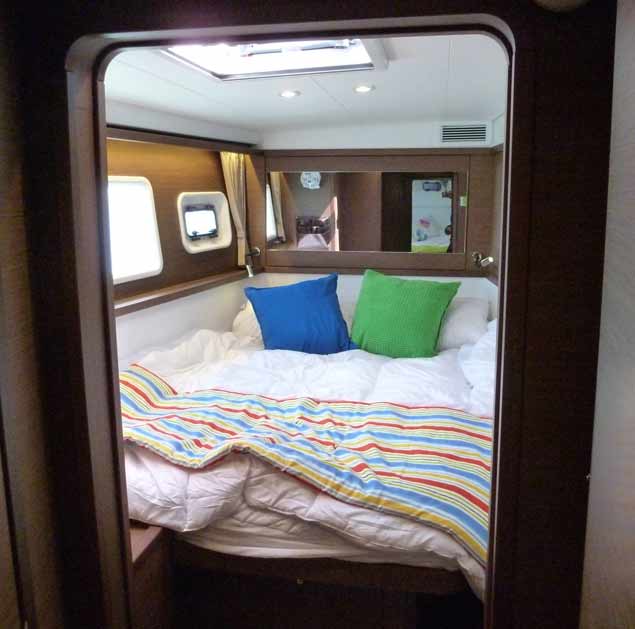 The guest cabin on the forward side of the port hull may not be quite as luxurious as the owner’s accommodation, but remember that it’s always level…. Photo: W M Nixon
The guest cabin on the forward side of the port hull may not be quite as luxurious as the owner’s accommodation, but remember that it’s always level…. Photo: W M Nixon
Self-reliance and the potential for ease of independence in anchoring were among George and Mary’s primary requirements, and it was typified by the setup for handling the ground tackle – anchors, chains and so forth – with a high-powered windlass neatly available to cope with laying and retrieving the 40kg Rocna anchor.
Most part-time cruisers think in terms of pontoon berths or using visitors moorings for overnight or prolonged stops, but the serious cruising community - which George and Mary have now joined – thinks primarily in terms of being able to anchor independently. When I contacted George on Monday evening of this week to find out how things were going now that everything was finally under way with Realta Bheag having made her departure from Dun Laoghaire last week, it was to find that they were heading into the south side of Dungarvan Bay and the handy passage anchorage close west of Helvick Harbour, confident in the knowledge that they’d find a secure independent overnight berth, and a restful night - which they duly enjoyed.
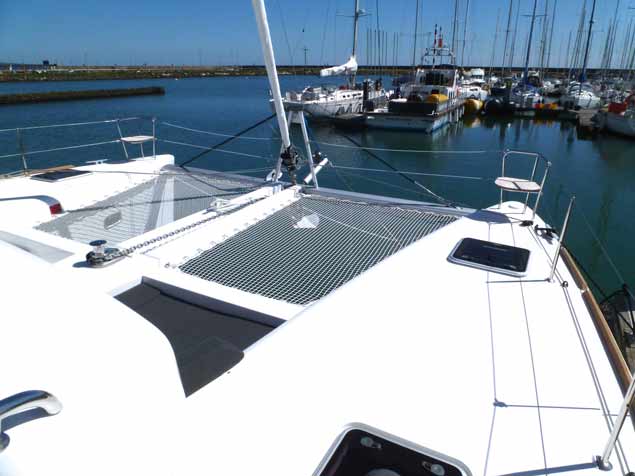 It may look like a vast outdoor play-space, but note how the forward deck’s effective and essential anchor chain and windlass setup is combined in the design, with the weight of the stowed chain kept well aft. The two stemhead seats are known as “the privacy corners”. Photo: W M Nixon
It may look like a vast outdoor play-space, but note how the forward deck’s effective and essential anchor chain and windlass setup is combined in the design, with the weight of the stowed chain kept well aft. The two stemhead seats are known as “the privacy corners”. Photo: W M Nixon
They’re headed initially in gentle stages towards West Cork before taking their departure for Portugal and eventually the Atlantic Rally For Cruisers from the Canaries in November, heading towards the Caribbean and taking in the Cape Verde islands option on the way. But since our first meeting in May, they’ve been busy with ensuring that their affairs at home will be in order while they have a prolonged absence, and there have been family events to cope with. As well, there has been a steady list of continuing mods to be made to the boat, for at all times possible since May, they’ve been putting in sea trials.
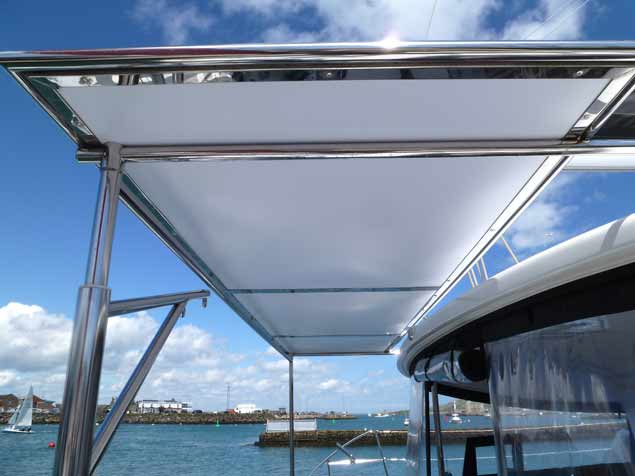 Solar panels have been installed on a special platform clear above the afterdeck to augment Realt Bheag’s philosophy of self-reliance. Photo: W M Nixon
Solar panels have been installed on a special platform clear above the afterdeck to augment Realt Bheag’s philosophy of self-reliance. Photo: W M Nixon
They were already familiar with Realta Bheag’s sea-going performance by the time she arrived in Ireland in late April, as they’d brought her up themselves from the builder’s commissioning port of Les Sables-d’Olonne. As part of the take-over package, a professional skipper set out with the new owners, but by Falmouth he said that George and his brother and Mary were clearly competent to complete the voyage to Ireland on their own, and thanks to successfully dealing with headwinds on the open Atlantic part of the passage, they arrived in Dun Laoghaire with added confidence in their new boat and their ability to handle her, and even more confident that they had made the right choice for their complex set of requirements.
So now, the voyage is under way. West Cork and its cruising associations means a lot to them, so before leaving Ireland, George and Mary and their crews – they’re currently crewed by his brother Declan and family friend Frances Doyle – hope to visit that Irish cruising paradise. But as they settle into the shipboard life, they’re doing it in easy stages down the Irish coast, and keeping a promise to call with Ross O’Leary who’s currently with MGM in Crosshaven for Volvo Cork Week, where the company is sponsoring the results system.
Quite where and when Realta Bheag’s final departure southward from Ireland takes place will depend on how the winds develop in the next week or three. But since early July, George and Mary Coombes have essentially been living on board Realta Bheag. She is now the centre of their life. The dream is on.
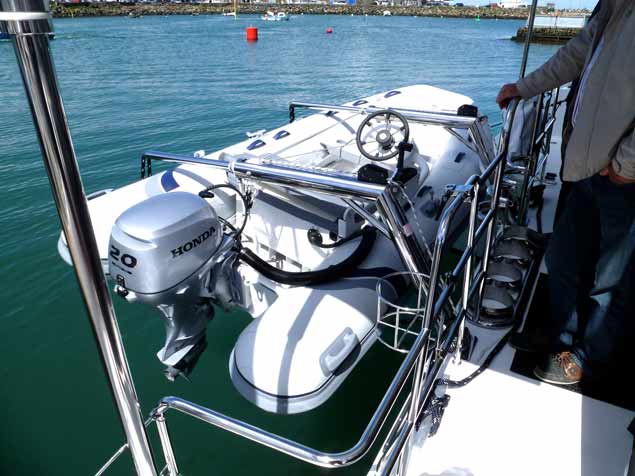 While Realt Bheag aspires to be a world unto herself, when the crew do want to go ashore, they expect a proper tender with an outboard of adequate power, launched by proper davits. Photo: W M Nixon
While Realt Bheag aspires to be a world unto herself, when the crew do want to go ashore, they expect a proper tender with an outboard of adequate power, launched by proper davits. Photo: W M Nixon
#lagoon52 – We've had enough of recession with its blighting effect on Ireland's marine industry. W M Nixon assembled a team who've kept going through thick and thin, and went sailing with them this week on a new vessel which challenges most perceptions of what a boat should be like.
It's time to wake up and smell the coffee. Time to shake off the torpor of economic recession and savour the aroma of new boats after six years of making do with the old. Time and more to go out and try something new, something different - something very different. So let's see if we can go out sailing on a new Lagoon 52, getting a team of all the talents and experience together to do the assessment.
The Lagoon range of cruising catamarans isn't utterly new. Though the Lagoon 52 is one of their most recent models, they've been in the multihull business in southwest France since 1984. But while their boats may leave two wakes astern, as a design development and production organisation they've been ploughing an increasingly individualistic single furrow for some time now, so much so that the simple word "boat" doesn't quite seem to fill the bill any more.
Yet for some people, a Lagoon is the only boat. The company's production facility is an autonomous unit within the enormous Beneteau umbrella by way of their link with Jeanneau. And as their speciality is big ticket catamarans with more than a certain je ne sais quoi, the firm turns over more euros than any other single part of the Beneteau galaxy.
But the company's growth was at a particular stage a dozen years which meant that it didn't try trading on the crazy boom years in Ireland. Maybe it's just as well. For now, with the faintest glimmerings of recovery in our marine industry, Lagoon – through their Irish agents MGM Boats - are putting a serious toe in the Irish water, even if the Lagoon 52 in particular has been developed with warm blue water cruising in mind.
As it's often the unorthodox operators who are emerging from the recession with something in the way of resources, so it's the unorthodox style of the Lagoons which appeals to a certain but real sector of the market. They'll be people who have shown themselves ready to seek out business in every last corner of the world where business might just have been done when everything was asleep at home in Ireland. People who don't have the old-fashioned notion of boat-owning as having your pride-and-joy based in the harbour nearest to home.
On the contrary, they'll be people who think it's only sensible to have your boat based where the sun shines and the sea is warm and the balmy breezes blow. People who reckon that when they're not using the boat themselves, then the boat should be able to do a bit of work for its own living. People, in short, who are certain that a boat like a Lagoon, which can be successful in a holiday area as both a charter operation and a private sailing project, is the only way to go.
Yet no sooner do you think you have these Lagoon owners neatly pigeon-holed, than one of them turns out to have bought one recently to base it at a marina near you in Ireland, just like anybody with an old-fashioned boat. But more of that anon. Meanwhile, what's with the Lagoon 52?
The main design and concept developers to Lagoon (who have their own in-house design department) is VPLP, the Marc Van-Peteghem/Lauriot Prevost consultancy and project management group, who cut their teeth with some formidable big total racing multihulls. It's still a significant area of their work, and that in turn gave them the expertise to create the huge multi-hulls used in the flawed cinematic masterpiece Waterworld starring Kevin Costner.
As for the Lagoon's accommodation layout and styling, they were master-minded by Masimo Gino of Nauta Design in Italy.
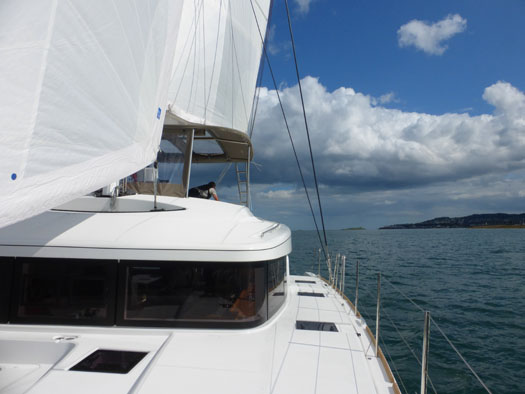
Stylish design of a high order. When the sun shines brightly on a Lagoon 52, you could be on the set for a photo shoot for an avant garde architectural journal. Some idea of the scale can be gauged from the crewman trimming the sheets on the flybridge. Photo: W M Nixon
Unless you've seen other earlier Lagoons, nothing quite prepares you for the appearance of the Lagoon 52. She seems much bigger than her overall length of 52ft (15.84m), but then she's bulked out with a beam of 28ft 3" (8.6m), although it's all on a manageable draft of 4ft 11 ins (1.5m).
However, even a 52 foot catamaran will still have much of her accommodation dictated by the relative slimness of the hulls which are the only units that provide what we might call inbuilt headroom. So the need for height has been met by building ever upwards. Essentially, the concept is of a sailing platform in which most of the full headroom is provided in the large deck saloon/galley area by adding elevation. And as this spacious setup is integrated with an extensive "patio" area aft by means of wide sliding doors, in order to provide a clearly delineated helming and control area the designers have simply continued on upwards with the cockpit – more accurately a fly bridge – on top of the deck saloon in a shallow well.

The hull profile shows that the fin keel is only vestigial in order to keep draft down below 5ft, yet the boat tacked with certainty every time.
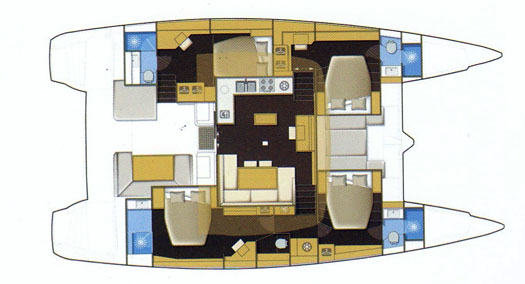
The 4X4 layout was the one we sailed
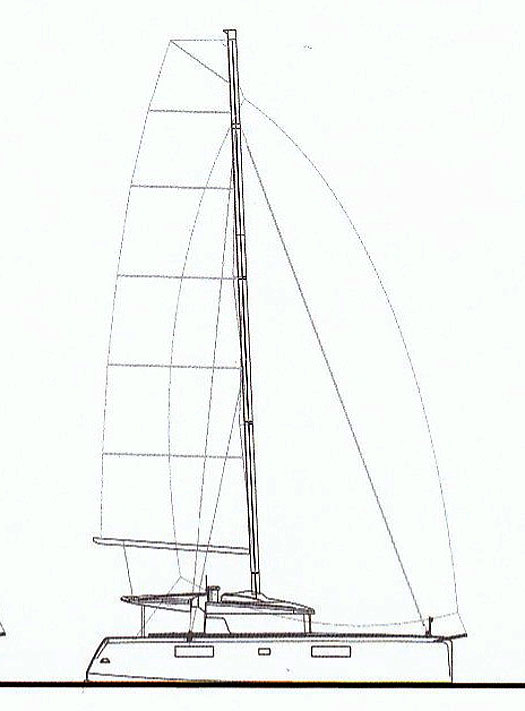
Is this a one-masted schooner? The amidships location of the mast reflects experience gained in big racing multihulls.
Thus we've a three storey boat. And the effect of height is accentuated by a substantial fractional sloop rig which tops out at 89ft 4ins (27.22m) above the waterline. As for the location of the mast, it comes down in the middle of the deck saloon (supported by a robust strut through the saloon itself), and thus is located almost amidships. This mast location is now almost a trademark of the VPLP racing multihulls, but in a boat of clearly cruising emphasis, you can't escape the feeling that this is really a one-masted schooner.

However you think about it or look at it, this is a three storey boat. Photo: David O'Brien
Whatever, it works and it works very well. But as I hadn't done any serious multi-hull offshore sailing since the briefly-held 1986 Round Ireland Record with Robin Knox-Johnston on the 60ft cat British Airways, everything pointed to an assembly of specialists to give the Lagoon 52 a going over, and first choice was Con Murphy and Cathy MacAleavey. These days they may be best known as parents of Olympic sailor Annalise Murphy and her remarkable siblings, but 21 years ago with Steve Fossett on the 60ft trimaran Lakota, they set a 44-hour Round Ireland Record so perfect that it still stands today despite several high powered challenges down the years.
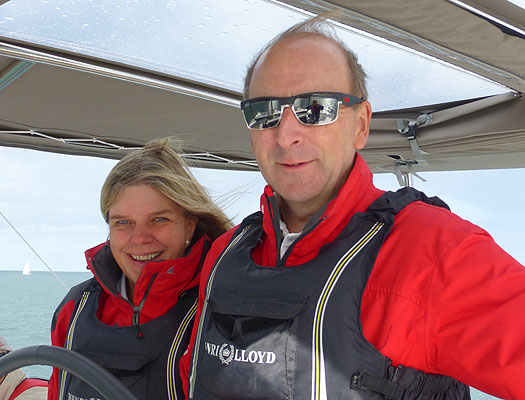
The Round Ireland Record Holders for 21 years and still counting – Cathy MacAleavey and Con Murphy on the helm aboard the Lagoon 52. Photo: W M Nixon
We also had Rod Martin who may be best known sailing a First 44.7 on Dublin Bay, but out west in the family place in Connemara they've a handy Dart 18 catamaran, thus Rod has sailed fast in a cat along the kind of challenging coastlines most of us only dream of or glimpse briefly. His wife Sally came too, and so did his shipmate Eddie Burkart, one of those practical guys you'll find delving energetically into the depths of the engine room when all about are gazing at the beauty of the sky.
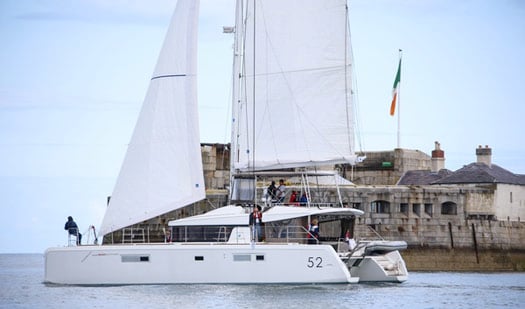
The great wind search as "Is Feider Linn" heads seaward past Dun Laoghaire lighthouse. Photo: David O'Brien
For a sensible practical input, we'd sailing couple Ian and Judith Malcolm who brought a wealth of experience, as Judith's family have owned a range of performance cruisers both power and sail, while Ian manages to be a stalwart of both the Water Wags and the Howth 17s. As for the realities of assessing longterm liveaboard viability, plus the practicalities of stowage for cruises of varied length together with the utility of the galley and the workability of the deck for those handling warps and so forth, my daughter Patricia came along as she and her husband Davy cruise their Oceanis 43 for four months every year in an extended voyage through the Med. But as they're home during late July and August to avoid the worst of the Med's heat and high summer crowds, she was keen to sail on a Lagoon 52 in Dublin Bay.
Out on the bay, there was no way she could complain that it was too hot or too crowded on Tuesday August 19th. We'd had a warm and lively lunch beforehand with everyone engrossed by Con and Cathy's tales of setting the record back in September 1993, and we'll have a blog about it here during the winter. But getting aboard in Dun Laoghaire Marina saw yet another of a series of downpours, and though it warmed up in bursts of sunshine which came hyper-bright in the radiant air, between times in rain and wind there is no doubting that the dogged remnants of Hurricane Bertha were still squatting over southern Norway and hauling Arctic air southward to mess up an entire month of the Irish Summer.

The things we do for our readers......heading towards a lurid looking cloud which could provide nothing better than 24 knots and a speed of 9.8. Photo: David O'Brien
Far from ideal conditions for a boat report, you might well think. But thanks to Ross O'Leary and his colleague Gerd from MGM Boats, we turned an unpromising afternoon to advantage, chasing wind where it might be found even if it was in the midst of rain, and gradually getting to know a boat which is just so different that you have to chuck all pre-conceived notions of "boatiness" out the window.
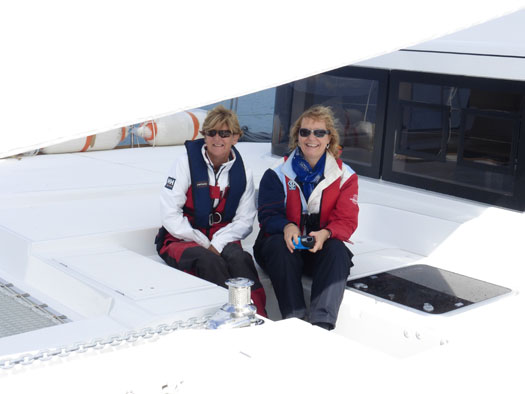
Judith and Patricia reckoned the forward cockpit was the bee's knees. Photo: W M Nixon

In a photo in which the lower half could be the Med but the upper half could only be Dublin Bay, the netting is the point – this is one of the best fun features on the boat, perfect for watching the bow-wave at play. Photo: W M Nixon
Ross was more than comfortable with the Lagoon 52 thanks to extensive experience with her, as she'd been brought up from Les Sables d'Olonne deep in Biscay on a circular delivery towards next month's Southampton Boat Show, taking in the Fastnet Rock and a spot of cruising in West Cork before shaping into Cork Harbour, then on past the Tuskar and into Dublin Bay.
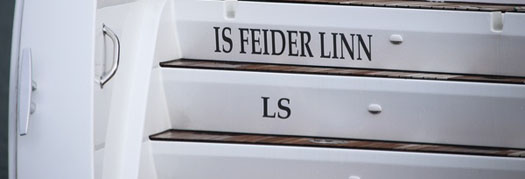
And why not? Cheery name for the new boat. Photo: David O'Brien
In honour of this pioneering visit to Ireland, the boat had been named Is Feidir Linn. The port of registry may be Les Sables, but "Yes We Can" seems the perfect name for a boat trying new markets in a recovering economy. And it was also an apt answer for anyone who wondered that such a sailing sky-scraper could go to sea at all, for not only had this boat made her voyage along Europe's Atlantic seaboard in a very unsettled summer, but sister-ships have crossed the Atlantic in increasing numbers to serve the Caribbean charter trade, matching the sailing experience of the first one to go across, which was regularly posting 200 day runs and had a best 24 hour sail of 220.

The bows exude distinctive style. Photo: David O'Brien
These are good figures, though by no means fantastic, but they reflect the reality that this is a blue water party platform for fun holidays - the fact that she can sail is almost a bonus. Even with our difficult weather conditions when we had to go chasing breeze where it might be found under lurid-looking clouds, we found she was soon sitting happily enough on a close reach at 7 knots in a moderate air, and when in one downpour we found a little bullet of 24 knots of wind, she was soon merrily ploughing her twin plumes at 9.8 knots with apparent wind at 70-80 degrees.
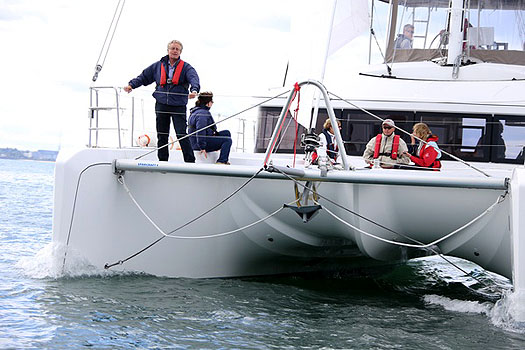
Monarch of all he surveys...Rod Martin is usually found sailing a First 44.7 on the east coast, and a Dart 18 on the west, so his views on the Lagoon 52 were of special interest. Photo: David O'Brien
In between the rain when the sun came out in hyper-bright bursts, a different boat emerged. It was as though we were on a photo set for an avant garde architectural journal. And the crew could enjoy the boat's many options. Les Girls thought the forward cockpit was the best place of all, well away from the nitty gritty of sailing, and free as a bird to enjoy the sense of flight above the water which was at its best when reclining in the netted trampoline decks forward, watching the ever-changing and soothing bow-wave.
Up top on the fly bridge, you're much more remote from the water, and the steering is equally remote – it helps that one of the panels on the dashboard tells you the rudder angle. However, once into the groove, she was fun to sail, and everyone was impressed by how positively she tacked. She never faltered once in dozens of tacks, which had not been our experience in some other catamarans.
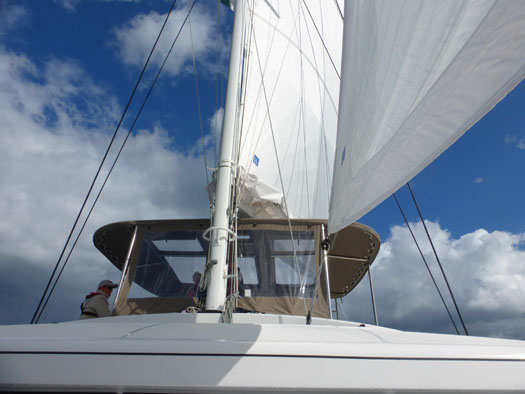
The seat of power – the flybridge is at quite some height. Photo: W M Nixon
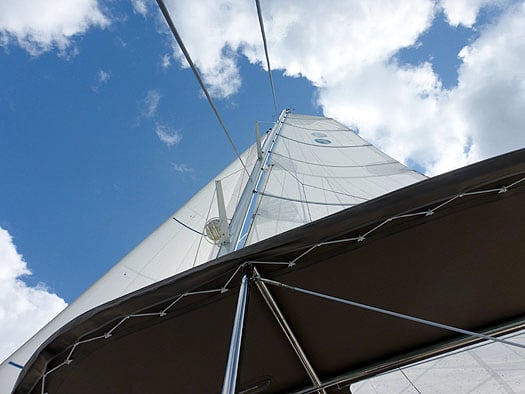
The source of power – the rig draws extensively on experience gained in racing. Photo: W M Nixon

Trade wind clouds over Dublin Bay? Dream on........Photo: W M Nixon
As for sail handling, the rig may seem remote in it towering heights, but there's no doubting its power. An orthodox sailor might be concerned that, for the final stow of the main in its stackpack, you've to climb a vertical ladder to the uppermost deck over the steering position. But when it came to do the job Gerd managed it with no bother whatever, and as for the ordinary sail handling during the course of the sail, a battery of electric winches does all the hard grind, while a neatly fitted self-tacking jib works a treat.
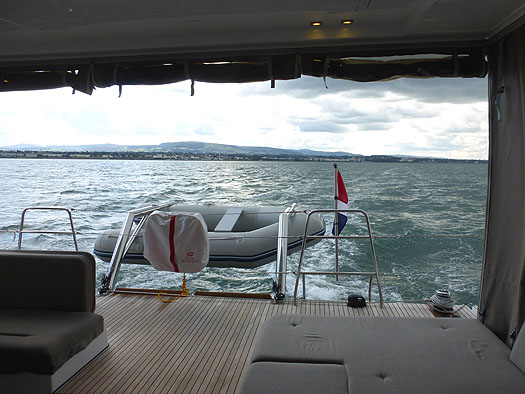
The best sailing of the day, but the sun won't shine. Photo: W M Nixon
In all, it's a potent looking rig developed from racing multi-hull experience, and as all the trimming equipment verges on the generous side, you can throw gybes and tacks without making a bother for anyone else on board, unless your new configuration of the sails blocks off the sun from their favourite sun-bathing position, which was mostly something we could only imagine on our showery day afloat.
It took as long to get a sense of the accommodation as it did to appraise the big boat's outer appearance. Once again you have to chuck out most of your old notions, as she only heels very little, and motion is mostly slight, albeit with sudden little jerks such as you experience on the cross channel fast catamaran ferry Jonathan Swift. As to ultimate stability, despite her towering appearance she feels ever more solid under foot with every mile sailed, for she chimes in at about 30 tons all up, and most of the weight is well down in the hulls.
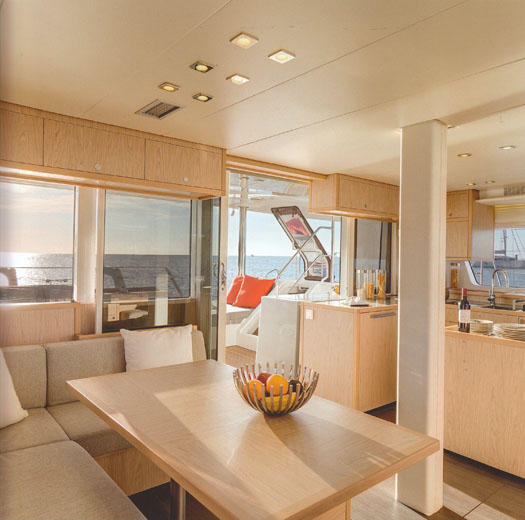
The cool style of the décor as seen in the main saloon is not necessarily to everyone's taste, but if you like it, you like it a lot.

Definitely for a sunny climate, where this large outer saloon area will provide welcome shade. Photo: W M Nixon

The roomy main stateroom is remarkably spacious for a catamaran. Photo: W M Nixon
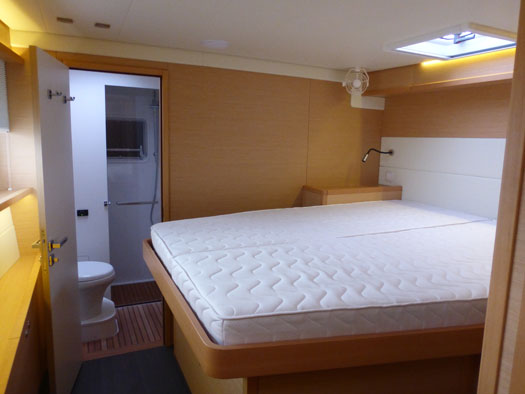
Being able to fit the double bunk athwartships in the forward cabin on the port side has been a real bonus. Photo: W M Nixon

A real sense of the spaciousness of the main saloon is seen in the depth of this shot from the entrance to the forward port cabin. Photo: W M Nixon
Thanks to being 52ft long, the hulls - while slim in multihull style - are still wide enough and deep enough to make a worthwhile contribution to comfortable cabins. In smaller cats, the double berths tend to be intimate tunnels running fore and aft, filling every available inch of the hull. But with the Lagoon 52 they've the space to install the double berths athwartships in three of the ensuite cabins, and the "master stateroom" on the starboard side aft is positively luxurious in its availability of space and style.
As to that ultra-wide multi-purpose saloon/control desk/galley and dining area, I first got a true impression if its enormous space when emerging from the forward cabin on the port side, looking up the steps and across the saloon to realize that the crewman sitting opposite was very far away indeed.
The boat we sailed was very comprehensively equipped, and you could see where the priorities lay – the fridge for the wine is handily in the galley, while the main working fridge is located at the foot of the stairway leading to the two starboard cabins. They're a nice touch, those stairs. For if those living aboard who find the inevitable partying is going on for too long, they can quietly slip away down these almost invisible exits and find their bunks in peace, leaving whoever is accommodated in the aft port stateroom to see the guests off the ship, as they can only get to their bunk via a very visible entrance off the cockpit area.
"Cockpit area" is just about the only way to describe the aft "veranda" in any nautical style. It's a wonderful space, and being comfortably ensconced within it gives you a much better impression of how the boat is trundling along in her merry way than if you're up in the fly bridge, which has a certain sense of remoteness no matter how long you are up there, even if you're using the special feature of the steering wheel which allows it to cant left or right to find your most comfortable steering position.
Not that you'll be using it for long, for with her efficient systems, this is a boat which will be largely steered by the auto-helm. And should they be needed, the 56hp engines with saildrives, neatly located in each hull down aft, move the Lagoon 52 very sweetly indeed with little fuss and less noise. In fact, with her ultra-modern architecturally-inspired appearance and ease of movement under quite small power packs, I suggested to Ross that she surely would make a very handy if unusual motor-cruiser. Not surprisingly, he said that there is already a handsome power version of the Lagoon 63 available which cruises at 12 knots and can reach 16 with very little bother, and in a very few weeks time there'll be a similar variant on the Lagoon 52.
But meanwhile, having squeezed every ounce of potential out of every last puff of wind available on Dublin Bay, we'd the chance to see how this bulky vessel could be fitted into her marina berth. By this time it was calm again and the sun had returned, gentle berthing conditions, but even so Ross gave a very smooth performance. Those of us new to the boat and watching from the height of the fly bridge got yet another perspective on her width and height by realising that the handy little blue boat way down to starboard as we reversed in was the Nicholson 58 Rebellion, while the slip of a tiny sloop just across the pontoon was George Sisk's Farr 42 WOW.
The abiding memory of the afternoon is of having a good time in congenial company. This tells us much about the spontaneous atmosphere aboard a Lagoon 52, but is scarcely conducive to filtering advice for anyone thinking of buying one of these remarkable boats. Not surprisingly in such a varied team, the views were mixed. All were pleasantly surprised by the boats readiness to tack without a bother, but initially they'd found that the helm at its remote heights seemed at a remove or two from sailing the boat, with a distinct lack of feel.
As to the performance, the frank conclusion was that this is really a motor-sailer. Certainly she'll sail along very well indeed when conditions are right, but that will be straight line sailing – for multi-directional sailing and up-close manoeuvring, you'll expect to call on the engine at least occasionally, and she doesn't seem to be a serious sailing proposition at anything higher than 55 degrees to the wind, while 60 to 90 degrees is her happy slot. If you have the chance to unfurl the big Code Zero with the wind freed, you're in business and then some, but it wasn't suitable for a hyper-gusty day on Dublin Bay.
However, the sail control systems were so efficient that everyone found they were soon forgetting the sheer area of sailcloth in use, even under simple working rig. There's a lot of power there.
The accommodation got wide approval, the excellent provision of stowage both in cabins and the general areas getting an enthusiastic thumbs up. Particular note was taken of the number of handy and capacious drawers – you'd be surprised how few drawers are installed in many modern production boats, leaving under-utilization of roomy stowage space which is otherwise difficult of access.
As for the general ambience of the finish and style in all the accommodation, the team thought it distinctly bland. When I pointed out this was probably to allow each owner a chance to make a personal style statement, I was tartly told that at these prices you'd expect the designers and builders to help them further along the way towards that personal touch. However, Patricia recalled meeting a couple who were cruising the bigger sister, the Lagoon 63, and she said that their boat had been so stylishly and effectively personalised to create a superb floating home that it took an effort to realize there was a standard Lagoon underneath it all.
So I looked up the information again, and found that in one statement Nauta Design asserted that they sought to provide the "association of geometric forms with "warm" materials, while optimizing the use of space", while in another comment Massimo Gino tells us that: "Our main objective has been to improve the use of space, providing sober, bright and comfortable living spaces, to suggest the "just like home" feeling for the owner and guests on board".
What with his ideas first being formulated in Italian and then into French and on into English, something may have been lost in the translation and "sober" is surely not the mot juste. But nevertheless the advanced Italian design style seems almost too cool for Irish tastes, with one of the panel suggesting that having the main part of the accommodation at deck level just didn't feel right, aboard a cruising boat they expected to descend into the warm ambience of a traditional saloon.
Maybe so, but our panel has had wide experience of sunshine cruising, and they said for that, particularly the in-port bit, the Lagoon 52 would be ideal, and they could already feel the pleasant breezes wafting through the spacious public areas as the boat lay gently to her mooring.
On the layout, there was general approval, but it was felt that though the important areas around the fly bridge were cleverly thought out in terms of space and access up stairways and so forth, there was a serious lack of any useful grabrails when going up or down. In fact, it was felt there was a lack of grabrails generally, but that may be because we were basically a team of mono-hull sailors and hadn't become accustomed to the different motion of a catamaran and it reduced need for handholds.
There was a feeling that the clear view forward from the seated steering position would not be unduly hampered by the provision of a pulpit rail at the forward end of the fly bridge for safety. As to the helmsman's seating, it might be much improved by having some sort of back rest. If Ireland's trawler skippers are prepared to spend more on their special chair on the bridge than on almost anything else, then surely a catamaran chiming in at more than €1 million could manage a comfortable seat rather than just a bench settee for the helmsman?
On deck, there was concern that although the provision of extra high three-wire guardrails round the side decks was very welcome, at the stern directly above the two transoms the removable gate wires were lower with just two – "It seemed to just ask you to fall overboard" was one comment.
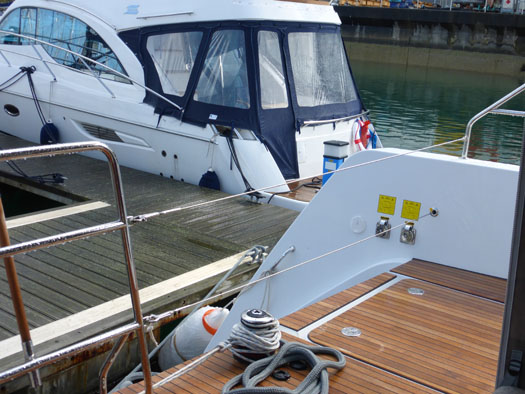
The gate guard rail above the transom had only two lines instead of the three on the rest of the boat, and it was thought this looked vulnerable. Photo: W M Nixon
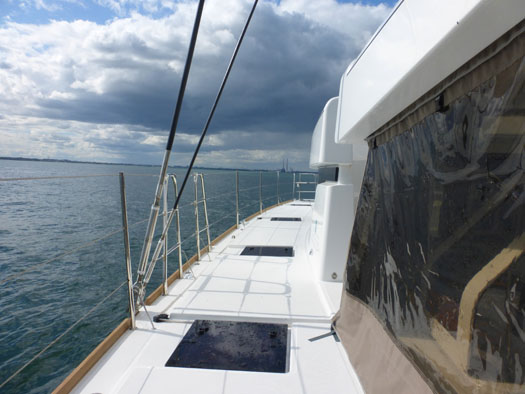
The sense of spaciousness and comfort on the wide decks would be enhanced by having a solid extrusion fitted along the top of the guard rails. Photo: W M Nixon
While the space and style of the deck impressed everyone, my own feeling was that it would be further improved by having a solid rail along the top of the guard rails. A curve of varnished teak in traditional style wouldn't be at all in keeping with the boat's look, but some sort of elegant plastic extrusion would not only be lower maintenance, but it would make the decks feel much more spacious and welcoming.
The boat as we sailed her is priced at €950,617 before VAT. A complex very fully equipped boat like this deserves much more than just one afternoon's sailing appraisal, but we have to deal with life in the real world, and anyone thinking seriously about the big step will put in many days of research.
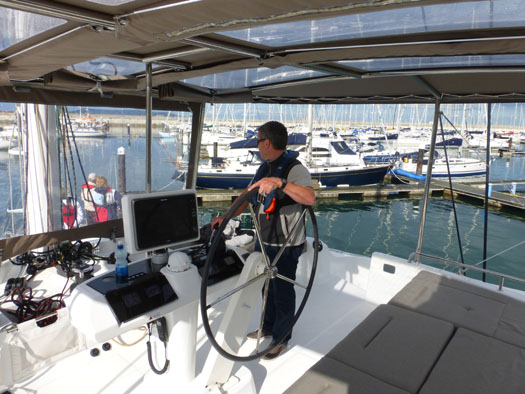
Bringing her in – from this height, the berth seems tight enough, and all other boat have shrunk. Photo: W M Nixon
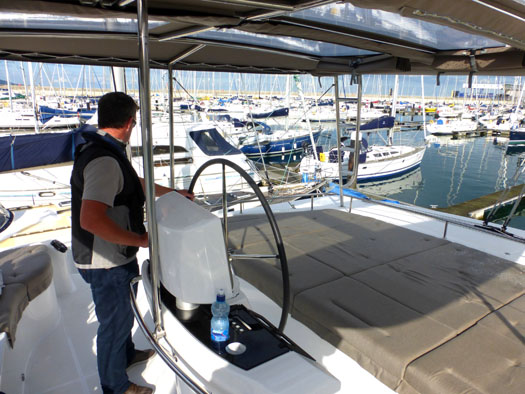
Snugly into the berth. For normal sailing looking forward, the test team though the helmsman deserved a proper seat with a back to it, instead of the backless lounging area as seen here. Photo: W M Nixon
Our test panel have all all reached the stage where they're veering towards classics rather than the latest in design, styling and technology. But when I mentioned that The New York Times insists on any restaurant being visited at least three separate times before they'll publish a review and that therefore we should continue our assessing of the Lagoon 52 in a sunny clime, the answer came in perfect unison: "When can we go?"
And as for that Lagoon catamaran being sold to a marina near you in Ireland, next day I popped over to Malahide to look, and there she was indeed, a Lagoon 39, owned by a keen sailor who was once a mono-hull man, but this is his second cruising cat.
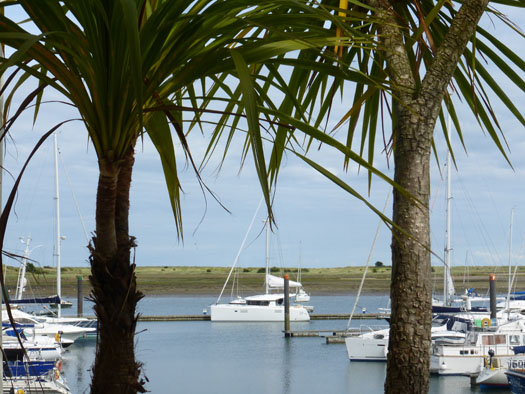
A Lagoon 39 in her home berth – could it be the Camargue perhaps.....?
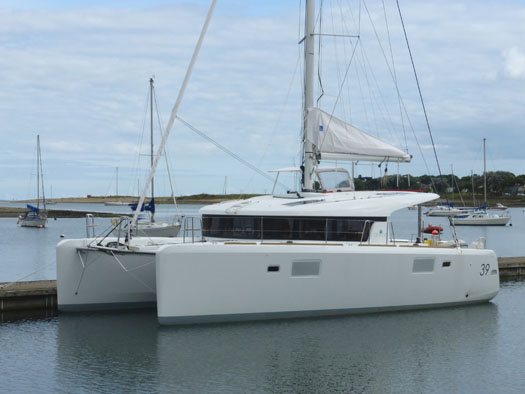
No, it's Malahide – but her deckhouse and hull reflects the style of her bigger sister the Lagoon 52. Photo: W M Nixon
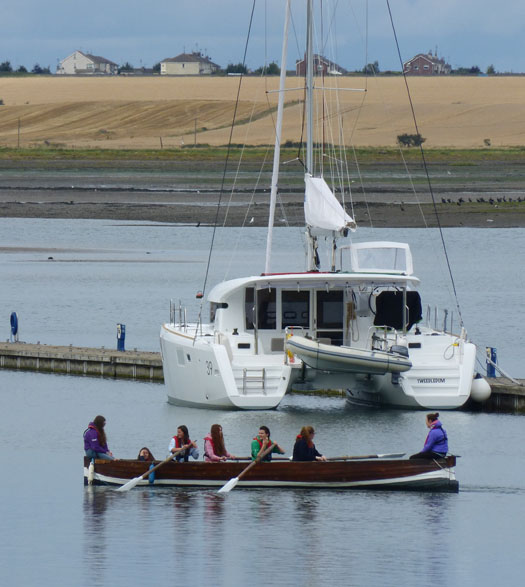
Definitely Malahide, with the ladies' skiff crew in training for next weekend's East Coast Championship in Dun Laoghaire, and the Lagoon 39 beyond. Photo: W M Nixon
The first view was through cordylines which looked enough like palm trees to give Malahide some exotic Riviera style, but after savouring that unique and extraordinarily attractive cabin design style again as replicated in the 39, I took another photo from the town waterfront, just as the local lady's skiff rowing crew were heading past, to show it was undoubtedly Malahide.
At the Sea Scouts' boathouse, they told me all their crews were in training for the East Coast Skiff Championship at Dun Laoghaire in the last weekend of August, just a week hence.
"Who are the top teams? I asked.
"Malahide are champions" came the chirpy reply. "That's all you need to know".
Quite.
Lagoon 52 Multihull Now Cruising Irish Shores
#multihullsnews – In a novel move from MGM Boats, the Irish boat sales firm have brought in a Lagoon 52 Cruising Catamarans from France for a ten week demonstration period around the Irish coast. From the above picture it's clear she's already done the rounds off Cork and is now heading to Dublin Bay for several weeks of demo–sail appointments at Dun Laoghaire.
The Lagoon 52 is a high volume cruising catamaran incorporating a large flybridge steering station, a radical aft-stepped mast and self-tacking genoa that makes this big yacht so easily managed by the smallest of crews. More on the boat on Afloat boats for sale here.



























